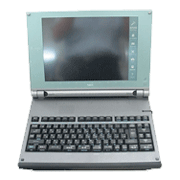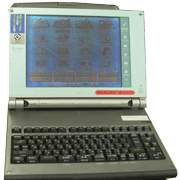NEC rolled out the Bungo JX-750 in September 1999. The JX-750 offered users faster, more seamless functionality with the addition of a voice-recognition feature, a touch button, and a detachable hand scanner.
- The JX-750 had the following features.
- (1)The JX-750 was developed around a 3S concept — simple, square, and skeletal — that aimed for a minimal exterior design with no excess or waste. The word processor won the 1999 Good Design Award (G-mark) for its forward-thinking design.
- (2)Printing and other operations could be done with the voice-recognition-driven menus, and postcards could be created by touching the screen instead of using a keyboard. Seven frequently used functions were accessible from the touch button.
- (3)The color scanner could scan at 800 dpi in the x-direction while attached to the word processor. It could also be detached and used as a hand scanner.
- (4)The internal 56 kbps high-speed modem gave seamless access to the Internet, e-mail, and other network communications.
- (5)The JX-750 came with the SpellVisor (a Japanese spellchecker), which performed 13 different kinds of checks, including typos, missing characters, kana written after kanji characters, homophones, and trademarks / trade names. It also featured help for creating documents, such as standard openings and closing and season’s greetings, that could be used in both business and private communications.
- (6)The high-speed color printer delivered quick and attractive prints even when printing large volumes of greeting cards or other media because it could print the message side or the address side of two postcards simultaneously.
| JX-750 | ||
|---|---|---|
| Introduced | September 1999 | |
| Display device | Monitor | Backlit, color LCD monitor (STN) 640 x 480 pixels, 184 x 245 mm (12.1-inch) |
| Horizontal text | 40 Japanese characters x 19 lines (20 x 16 dots, standard display) 80 Japanese characters x 38 lines (10 x 8 dots, condensed display) 20 Japanese characters x 9 lines (40 x 32 dots, expanded display) |
|
| Vertical text | 25 Japanese characters x 30 lines (20 x 16 dots, standard display) 50 Japanese characters x 60 lines (10 x 8 dots, condensed display) 12 Japanese characters x 15 lines (40 x 32 dots, expanded display) |
|
| Entry devices | Keyboard | JIS standard layout (alphanumeric and kana) |
| Entry modes | JIS input, alphanumeric input, radical input, JIS code, numeric keypad input, symbol input, extended character input | |
| Conversion methods | AI conversion, clause-level conversion (200 characters / 40 clauses), convert all (clause conversion), kana-kanji conversion, etc. | |
| Dictionary Dictionaries Standard AI Word management |
2.02 million words ~530,000 words ~1.16 million candidate words Storable (~3000 words: two-character word: three-character reading) |
|
| Standard characters | 1990 JIS standard characters | |
| Extended characters | 1990 JIS standard characters 10 characters (basic) 104 characters (system extended characters) |
|
| Number of characters | Japanese typefaces: 7,382 characters Edo characters: JIS Level 1 + 109 characters Variant name characters: 990 Extended characters: 184 |
|
| Printing device | Printer Speed Paper widths |
160-dot multi-line printer 225 characters/second (when line spacing set to 53 dots and character spacing set to 0) Prepaid postcard to B4 widths |
| Other specifications | External dimensions [mm] Weight Power consumption |
362 x 394 x 96 (w x d x h) 6.5kg 55 W max., 19 W, standby |



